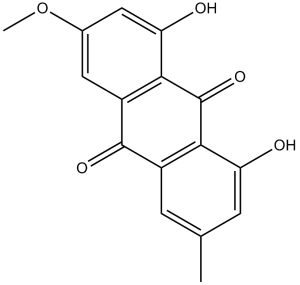This product is for research use only, not for human use. We do not sell to patients.

| Size | Price | Stock |
|---|---|---|
| 250mg | $480 | Check With Us |
| 500mg | $800 | Check With Us |
| 1g | $1200 | Check With Us |
Cat #: V2016 CAS #: 521-61-9 Purity ≥ 98%
Description: Physcion (also known as Physcione) is a naturally occuring anthraquinone isolated from roots of Rheum officinale Baill. Physcion has been commercialised in China for controlling powdery mildews. Physcion controls powdery mildew mainly through changing the expression of defence-related genes, and especially enhancing expression of leaf-specific thionin in barley leaves. Rhein induces apoptosis in cancer cell lines and inhibits transforming growth factor β-1 induced plasminogen activator inhibitor-1 in endothelial cells.
Publications Citing InvivoChem Products
Product Promise

- Physicochemical and Storage Information
- Protocol
- Related Biological Data
- Stock Solution Preparation
- Quality Control Documentation
| Molecular Weight (MW) | 284.26 |
|---|---|
| Molecular Formula | C16H12O5 |
| CAS No. | 521-61-9 |
| Storage | -20℃ for 3 years in powder formr |
| -80℃ for 2 years in solvent | |
| Solubility In Vitro | DMSO: <1 mg/mLr |
| Water: <1 mg/mLr | |
| Ethanol: <1 mg/mL | |
| SMILES Code | O=C1C2=C(C=C(C)C=C2O)C(C3=CC(OC)=CC(O)=C13)=O |
| Synonyms | NSC-251670; NSC 251670; NSC251670; Physcione; Physcion; 6-O-methyl Emodin; |
| Protocol | In Vitro | In vitro activity: Physcion has been commercialised in China for controlling powdery mildews. Physcion controls powdery mildew mainly through changing the expression of defence-related genes, and especially enhancing expression of leaf-specific thionin in barley leaves |
|---|
| Solvent volume to be added | Mass (the weight of a compound) | |||
|---|---|---|---|---|
| Mother liquor concentration | 1mg | 5mg | 10mg | 20mg |
| 1mM | 3.5179 mL | 17.5895 mL | 35.1791 mL | 70.3581 mL |
| 5mM | 0.7036 mL | 3.5179 mL | 7.0358 mL | 14.0716 mL |
| 10mM | 0.3518 mL | 1.7590 mL | 3.5179 mL | 7.0358 mL |
| 20mM | 0.1759 mL | 0.8795 mL | 1.7590 mL | 3.5179 mL |
This equation is commonly abbreviated as: C1 V1 = C2 V2
- (1) Please be sure that the solution is clear before the addition of next solvent. Dissolution methods like vortex, ultrasound or warming and heat may be used to aid dissolving.
- (2) Be sure to add the solvent(s) in order.




































